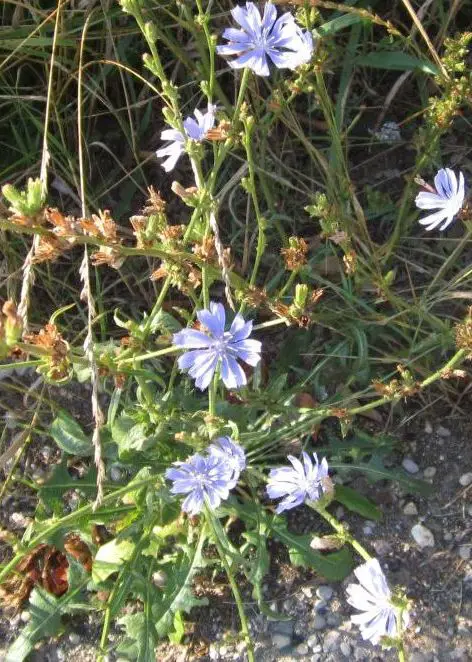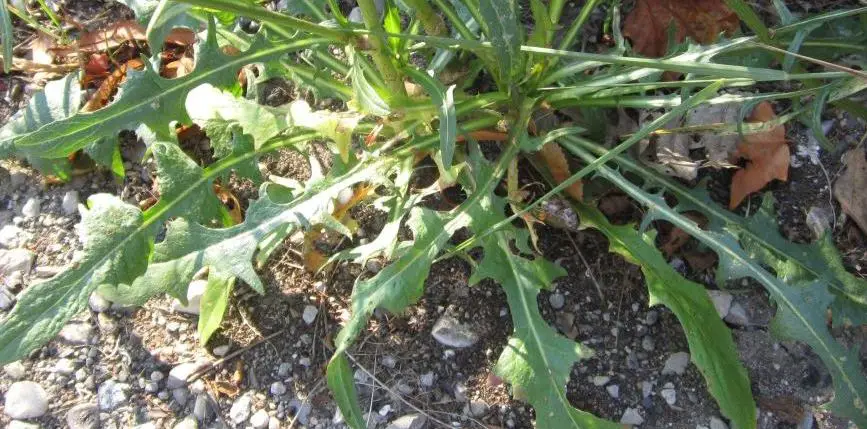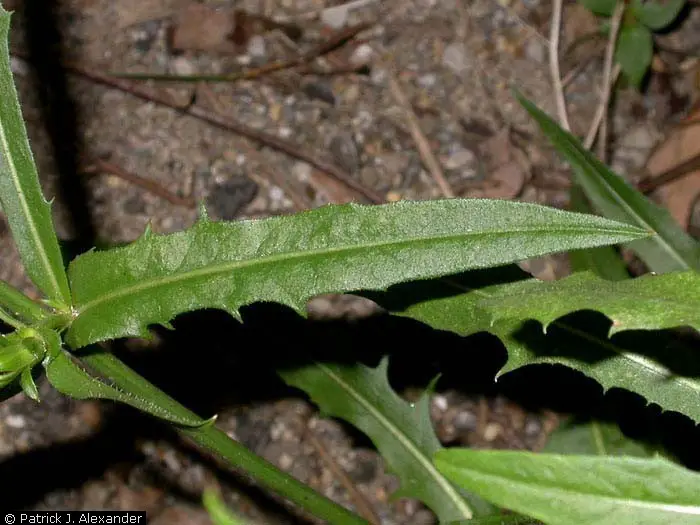
Search Wild Foods Home Garden & Nature's Restaurant Websites:
Chicory

(NOTE: If you are not interested in growing Chicory, but just finding the plant and using it, try going to the Nature's Restaurant Online site for Chicory.)
Chicory (Cichorium intybus) leaves. The leaves from this plant are a highly appreciated vegetable all over Europe. Often grown without light (Blanching) which makes them less bitter and white. A variation of this plant is sold as Endive (Cichorium endivia). This plant is very common to see along the side of roads and walking paths.
Is the growing of this plant compatible with Natural farming, Ecoagriculture or Eco friendly agriculture, Ecological farming, Sustainable agriculture, Agroforestry or Agro-sylviculture and Permaculture: This plant works well with Natural farming, no-till gardening methods. You have to disturb the soil when harvesting the roots, but there is no need to till the soil, especially if the soil is loose, and open. If you will not be harvesting the roots, and growing just for the greens, the soil around this perennial will never need disturbing.
Like many plants, there are the two basic ways of getting this plant into your garden. One is by seed, the other by transplanting mature plants.
Seeds: Gather the seeds, and plant right after gathering them in late summer or early fall, or save for planting in the spring after the ground thaws. This is a plant you can buy seeds for in most seed catalogues. If you buy seeds in the spring, plant right after the ground thaws up to the normal time you would plant most sensitive vegetables, or wait until late summer.
Soil & Site: Though this plant does well in heavy soils, give them a better chance by turning heavy soil over and raking smooth. If you want to grow them for the roots, you need to have loose, loamy soil for 25 cm (10 inches) deep. They need a good amount of sun, but other than that, they are fairly tolerant of a variety of conditions. They can handle dry conditions very well, but do better with regular moisture. A very good plant for gardens with hard clay soils if you are growing for the greens only.
Planting: You can put one seed per 3 mm (1/8 inch) deep inch hole spaced about every 30 cm (12 inches) or, spread sparsely over the soil, rake lightly, tamp down and leave it other than watering. Keep the soil moist until established. A thin mulch will help keep the soil around the seeds moist.
Transplanting: You can transplant in the spring or fall. In the spring, before the plant produces a stalk, it is easy to mistake for a Dandelion. Once the plant forms a central stalk, you know it must be a Chicory, as Dandelions never produce a stalk. If you find some in the summer or early fall, make note of where they are and wait until the leaves are falling from the trees before you transplant. You have to go down quite a way to get a lot of the root. If done in the fall, cut off most of the upper stalk, leaving about 10 cm (4 inches) above the ground. If done in the spring, cut off the stalk if it has one, but not the basal (base) leaves. Using a shovel, make four cuts in the ground forming a square around the base of the plant. On the last cut, pry out the plant. Put in a bucket, cardboard box, or shopping bag and take home and plant. If it was transplanted in the spring, water well until it starts re-growing a stalk, if done in the fall, put mulch over it. You should have it take unless you broke off too much of the root.
Harvesting: Before the plant flowers, some people find the leaves not too bitter to eat raw, but once there are flowers on the plant, the leaves are so bitter that you must boil them in water (pouring the water away) before using in meals. However, they are not bitter because of any poison that will hurt you, it is just a taste issue. There are cultures that appreciate the bitterness, and I have to say, after years of eating the leaves from this plant and the Dandelion, you do grow used to it to the point it is not unpleasant.
You can harvest the roots all season long, but they are best in the early spring or later in the fall. Just dig up with shovel. In heavy soils, the roots can be multiple, thin roots that aren't much use. In soft, loamy soils, there tends to be a nice, useful, single tap root.
Using: Once boiled and the water poured off, you can use the leafy greens in any recipe. I find they go well with tomato sauces and in stir-fry's. I suggest that if you are not used to the bitter taste, boil for longer than is needed to cook them, pour off the water, add fresh water, bring to a boil again, pour that water off, then use the greens. It is true you will lose some of the nutrients by doing this, but it is a good way to get used to the taste, and you can do only one water change in time. You can also deprive them of sun for a week or two before harvesting the leaves, which helps reduce the bitterness somewhat. Follow the instructions in the Dandelion section for how to do that. Cut off the stalks before doing this - you won't hurt the plant.
There are different uses for the Chicory roots, and you can find them by following the recipe links below the description. I personally only use them one way: I use them the way I use Dandelion roots for coffee. Well washed, chopped up, roasted and stored until I put some in water the night before for making coffee with the next morning. My personal favorite is to mix half and half roasted Chicory and Dandelion root in a jar and use that mix for the coffee water. See Dandelion section for more on how I do it.
Description:
- USDA Plant Hardiness Zone: 2-9 (More information on hardiness zones).
- Soil pH: 4.5-8.3 (best is 5.5-7.5)
- Plant Size: generally 30-100 cm (10 to 40 inches), however can grow up to 1.5 meters (5 feet)
- Duration: Perennial
- Leaf Shape: Quite variable, even on the same plant. Some are Lanceolate, while some are Pinnatisect. Easiest way to describe them is say the bigger leaves look like Dandelion leaves, while leaves on stalks (Dandelions don't have stalks) can look like Dandelion leaves or completely smooth edged (usually the smaller leaves). Base of leaves on Stalks wrap around each side of the stalk, but not all the way around.
- Leaf Phyllotaxis (Arrangement) on stem: Alternate
- Leaf Size: Highly variable: 5-35 cm (2 to 14 inches) long
- Leaf Margin: Quite variable, even on same plant. Some are deeply lobed with an irregular sawtooth, some are perfectly Entire (smooth edged)
- Flowers: Usually in the blue range: bright blue to light sky-blue to cornflower-blue to mauve-blue to mauve. Can be mixes of colors on same plant. Each flower can be a mix of colors. Rarely: white or light pink. 2-4 cm (3/4 to 1 1/2 inches) wide
- Fruit: small seeds, tan to brown sometimes spotted, wedge shaped with wide end having short whitish fuzz.
- Stem: Green to reddish-brown. Hairy near base, no hairs on upper sections.
- Habitat: Needs full sun, or very little shade. Rocky, sandy, or clay soils. Can grow in acidic or alkaline soils. Soils need to be well drained, but prefers moist soils. Waste areas, grasslands, roadsides, abandoned fields, edges of woods.
Web Resources:
- Recipe search on the web here (Google search) and here (Bing search).
- Pictures on the web here (Google images) and here (Bing images).
- Interactive USDA distribution map and plant profile here.
- The Biota of North America Program (BONAP) distribution map here. BONAP map color key here.

Chicory (Cichorium intybus) range. Distribution map courtesy of U. S. Department of Agriculture (USDA Natural Resources Service) and used in accordance with their policies.
Typical Chicory plant. Picture taken in mid August.

Chicory in flower.

The basal leaves of the Chicory plant. They look like Dandelion leaves.

Chicory (Cichorium intybus) seeds. (Steve Hurst, hosted by the USDA-NRCS PLANTS Database)

Basal leaves of a different Chicory. Notice how different they are from the ones above. The leaves are quite variable in margin shape. (Patrick J. Alexander, hosted by the USDA-NRCS PLANTS Database)

Drawing. (USDA-NRCS PLANTS Database / Britton, N.L., and A. Brown. 1913. An illustrated flora of the northern United States, Canada and the British Possessions. 3 vols. Charles Scribner's Sons, New York. Vol. 3: 305)
Search Wild Foods Home Garden & Nature's Restaurant Websites:
Share:
Why does this site have ads?
Originally the content in this site was a book that was sold through Amazon worldwide. However, I wanted the information to available to everyone free of charge, so I made this website. The ads on the site help cover the cost of maintaining the site and keeping it available.
Google + profile
